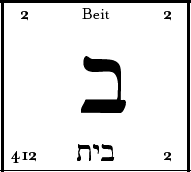A • B • C • D • E •
F • G • H • I • J • K • L •
M
N • O • P • Q • R •
S • T • U • V • W • X • Y •
Z
Hebrew:
Aleph • Beit • Geemel • Dalet •
Hay • Vahv • Zaiyin • Chait • Tait
Yoad • Kaf • Lahmed • Mame • Nune •
Sahmek • Aiyin • Pay
Tzahday • Qoaf •
Raysh • S(h)een • Tahv

Beit
Spelling: beit yoad tahv
Beit signifies
a house or box with an opening, and is commonly associated with
the idea of ‘a house’ — a container into
which the glories (growing reflective complexity) and blessings
of our celestial sources are magnified, reflected, and embodied.
It is associated with enclosures or limiting containers, and a way
of collecting things together. Also with the quality of ‘being
within’ such as belonging to a family. In general this letter
represents ‘the structure’ or form within which energies accrue
stable manifestation. The important thing to realize is that this
is extremely general — think of the most essential or ‘elemental’
aspect of structure — the precursor to any ‘manifest’ structure
— that’s beit.
One’s house is representative of one’s relation to all other things,
circumstances and beings, thus the character of the house sets
the character of relation. There is the additional ‘feminine’ quality
of the
house as being attractive and receptive; a shelter of comfort.
The Torah (or pentateuch) begins with this letter, and the open
side leads into the rest of the book, which ends with lahmed — ‘the
pointer’ of a teacher. For this and other reasons, beit is ascribed
a profound quality of ‘firstness’ second
only to aleph. It also signifies ‘secondness’ — for
example the arisal of marriage after the meeting of those who will
be wed. It is often construed as being composed of three vahvs,
which are themselves begun with three yoads. This illustrates the
profound self-referencing quality of the Hebrew alphabet, and the
omnipresence of God, ‘the point’.
In the Zohar there is an allegorical story where each of the letters,
which can be seen as divine servants, come before God to present
themselves as hopefuls for the foundation of the World. The letters
present themselves in reverse order, last to first, and each are,
in turn, found to have some preclusive quality. Finally, beit is
eventually chosen, due to its association with the inherently Blessed
nature of God (beit begins the Hebrew word barak (beit
raysh kaf-sophit) or blessing). After beit’s
presentation and ennoblement, aleph is given an even greater gift:
to be the
first
letter of
all, and to become forever the elemental signifier of perfect unity.
Beit also signifies the quality of dividing in a unique way, the
way a son (ben — beit nun-sophit) is a unique yet
complete child of its parents (pair-ents). In English, this quality
is represented by the prefix ‘bi-’.
o:O:o
Family: Archetypal: A seed or primieval force from
which the existential and supernal are actualized. Existing outside
of space and time. The first 9 letters.
Archetypal: Beit
Existential: Kaf
Supernal: Raysh
Position: The second letter. First of ‘the
doubles’, letters which have a dual pronunciation (hard or
soft) with the exception of reish. This can be understood as a
polarity between a quality and its derivative opposite, and also
a harsh or lenient perspective of judgement.
Common associations:
Primary Significations: A tent or house. A place of gathering
the family. A box.
Secondary Significations: Wisdom/Folly. Ownership, land, property.
Enclosure or shelter. The first day of Creation.
Body: The right eye.
Planet: The moon.
Archetype / Tribe: Abraham
Element:
Path on the Tree of Life:
Traditional: Chockma / Chesed
Hermetic: Keter / Binah
Beit
A • B • C • D • E • F • G • H • I • J • K • L • M
N • O • P • Q • R • S • T • U • V • W • X • Y • Z
Hebrew:
Aleph • Beit • Geemel • Dalet • Hay • Vahv • Zaiyin • Chait • Tait
Yoad • Kaf • Lahmed • Mame • Nune • Sahmek • Aiyin • Pay
Tzahday • Qoaf • Raysh • S(h)een • Tahv